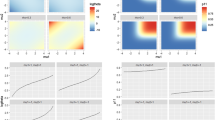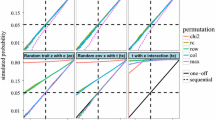Summary
The method of estimating interactions proposed independently by Pimm and Schoener is studied using field data from the community of rodents which lives in the arid, rocky habitats of Israel. One important problem the method addresses is how to remove the effects of habitat heterogeneity on the estimate. We tried six different variations of the analysis scheme outlined by Crowell and Pimm, and found their results qualitatively inconsistent. This was especially true when we compared the results produced from separate habitat variables with those produced from the principal components of the habitat variation.
Another problem, this one not previously addressed, is great variation in the average abundance of the different species. We discovered that the ratio of the average abundances of two species is the best predictor of the value of their coefficients of interaction. Common species appear to have weak influence on rare ones; rare ones appear to have strong influence on common ones. The statistical mechanism which produces this relationship is clear, indicating that the relationship is an artifact.
Similar content being viewed by others
References
Abramsky Z, Rosenzweig ML, Brand S (1985) Habitat selection in Israel desert rodents: comparison of a traditional and a new method of analysis. Oikos (in press)
Abramsky ZA, Bowers M, Rosenzweig ML Detecting interspecific competition in the field: testing the regression model of Crowell and Pimm (in preparation)
Crowell K, Pimm SL (1976) Competition and niche shifts of mice introduced onto small islands. Oikos 27:251–258
Fretwell SD (1972) Populations in a Seasonal Environment. Princeton University Press, Princeton, NJ
Hallett JG (1982) Habitat selection and the community matrix of a desert small-mammal fauna. Ecology 63:1400–1410
Hallett JG, Pimm SL (1979) Direct estimation of competition. Amer Natur 113:593–600
MacArthur RH, Levins R (1967) The limiting similarity of convergence and divergence of coexisting species. Amer Natur 101:377–385
Morisita M (1969) Measuring of habitat value by the “Environmental Density” method. In: Patil GP, Pielou EC, Waters WE (eds) Statistical Ecology, Vol. 1. Spatial Patterns and Statistical Distribution. Penn State Univ Press, University Park, PA Vol 1: pp 379–401
Rosenzweig ML, Abramsky Z, Brand S (1984) Estimating species interactions in heterogeneous environments. Oikos 43:329–340
Rosenzweig ML, Abramsky Z Detecting density dependent habitat selection. (under review)
Schoener TW (1974) Competition and the form of habitat shift. Theor Pop Biol 6:265–307
Schoener TW (1975) Presence and absence of habitat shift in some widespread lizard species. Ecol Monogr 45:233–258
Author information
Authors and Affiliations
Rights and permissions
About this article
Cite this article
Rosenzweig, M.L., Abramsky, Z., Kotler, B. et al. Can interaction coefficients be determined from cencus data?. Oecologia 66, 194–198 (1985). https://doi.org/10.1007/BF00379854
Received:
Issue Date:
DOI: https://doi.org/10.1007/BF00379854




